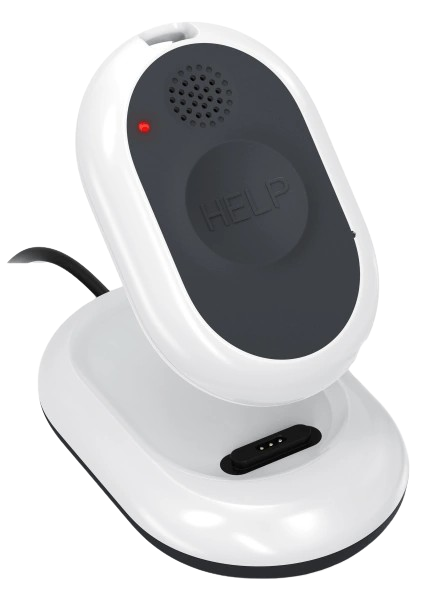Canada is divided into federal and provincial/territorial jurisdictions for laws and policies. When it comes to employment policies for lone workers, most provinces, including New Brunswick, follow Canada’s federal Occupational Health and Safety Code.
New Brunswick also has its own best practices and recommendations for employing or working as lone workers. This page will provide a summary of these recommendations for employers in New Brunswick who may have lone workers in their businesses.
On This Page
Our Guide To Lone Worker Safety Policy And Legislation In New Brunswick
In New Brunswick, working alone can present significant safety risks, requiring employers to adhere to both provincial regulations and Canadian federal laws to protect lone workers effectively.
This page will highlight the essential details for employers in New Brunswick, focusing on compliance with the hazard assessment and control requirements outlined in the Occupational Health & Safety Code (OHS).
How New Brunswick Defines A Lone Worker
Although New Brunswick does not officially define “lone worker”, a lone worker in New Brunswick can generally be determined if they are the only employee working at an employer’s workplace where help is not readily available in the event of an injury, ill health, or other emergency.
Employing A Lone Worker In New Brunswick
When employing a lone worker in New Brunswick it is important to establish a “code of practice”. A code of practice has specific requirements, and must include details such as:
- Name, address, location and telephone number of the workplace, employer, and place of employment;
- Identification of any hazards and risks of the workplace;
- Procedures to follow to minimize the danger of the hazards and risks of the workplace;
- Emergency response activation and procedures.
Devices such as a Lone Worker Man Down Alert can help employer’s maintain their code of practice and protect their employers and business.
Learn How You Can Protect Your Employees With Loneworker.com

With Loneworker.com you can be equipped with the knowledge and the means to protect your employees and protect your business. Contact us today to learn more about how Loneworker.com can protect you and your employees.
How The Safe Lone Worker App Can Protect New Brunswick Lone Workers And Employers
An important part of keeping your lone workers safe is providing quick and easy communication and monitoring in the event of an emergency.
With the Safe Lone Worker App, you can easily monitor your employees' while they are carrying out their responsibilities, even if they are travelling alone. The app works in tandem with a man down alert button that can be pressed in the event of an emergency. If the button is pushed, the lone worker will be immediately put into contact with a monitoring center that can send help immediately and contact the employer.
New Brunswick Lone Worker Policies
The content below has been included as a direct reference for lone worker policies as provided by New Brunswick. This content has been included to serve as more detailed information and an easy reference point. This information is provided for your convenience, but should not be taken as legal advice. We encourage you to conduct your own research into the laws and regulations of your jurisdiction before making any decisions.
Introduction
Employers must establish a code of practice for all employees who work alone. While the regulation does not specify a definition for the term “working alone”, for the purposes of this regulation, an employee is “working alone” at a workplace if they are the employer's only employee at the workplace and working in circumstances where help is not readily available in the event of an injury, ill health, or emergency.
Circumstances where a code of practice could be required include:
- Working alone at hazardous work; for example, in oil and gas fields, or a mechanic working alone under a car.
- Working in isolation; for example, custodians and security guards or maintenance workers.
- Meeting clients away from the office; for example, home care workers, nurses, government enforcement officers, social service workers, or real estate agents.
- Working alone and handling cash; for example, convenience store clerks, retail service and food outlet workers, or taxi drivers.
The regulations also specify situations where working alone is prohibited. It is not permitted to work alone:
- In confined spaces.
- When operating a chainsaw, brush saw or clearing saw.
- When performing underwater diving operations.
- Where there is a risk of drowning unless the employee wears a life jacket.
Learn How The Lone Worker Monitoring Device Works.

By using a Safe Lone Worker Man Down alert you can monitoring your employees and keep them safe even while they are travelling or working on their own.
Our devices are equipped with cellular and GPS technology to provide service all across Canada and the United States of America.
Contact us today to get your Safe Lone Worker Man Down Alerts for you and your business.
As the employer, you must:
- Identify all jobs and tasks that may be conducted by the employee while working alone.
- Develop and implement a code of practice for working alone.
- The code of practice must include:
- Name, address, location and telephone number of the workplace
- Name, address, location and telephone number of the employer
- Nature of the business conducted at the place of employment (for example, retail)
- Identification of any risk that arises out of or in connection with the work assigned (for example, risk: violence)
- Procedures to follow to minimize the risks identified in the sections above
- Communication methods
- Emergency response activation and procedures
- Communicate the code of practice.
- Train the employees working alone and their supervisors on appropriate safe working alone procedures.
- Provide the materials and equipment identified in the code of practice for working alone.
- Ensure the code of practice for working alone is followed.
- Review the code of practice for working alone periodically and revise it as necessary.
While the employer is ultimately responsible for all the provisions mentioned above, the supervisor has a vital role to play in the safety of their teams. As a supervisor, you must:
- Acquaint your employees with the hazards and control measures associated with their work
- Provide the information and instruction necessary to ensure their health and safety
- Enforce company safety rules, programs, codes of practice and procedures, including ensuring employees comply with the requirements below.
As the employee, you must:
- Be aware of the hazards of working alone.
- Participate in the training offered by your employer.
- Know and follow your employer's code of practice.
- Report any incidents to your employer.
- Report any hazards to your employer or supervisor.
- Help identify hazards and control measures.
Factors to consider when assessing the risk of working alone:
- Remoteness of the location. (Also consider situations not normally associated with ‘remoteness'. For example, the security staff who walk the perimeter of the property by themselves or the clerk who is not in direct sightlines with any other employee.)
- Characteristics of the location (wilderness, industrial area, etc.).
- Transportation means.
- Availability of emergency assistance.
- Response time in emergencies.
- Time needed to complete the task.
- Time of day the job/task is performed.
- Type of work.
- Weather conditions.
- Potential for exposure to aggressive or violent behaviour.
- Potential for critical injury.
- Communication means.
- Employee's physical and psychological fitness for working alone.
Best practices to control hazards when working alone
It is the employer's duty to identify reasonable measures to take to protect the health and safety of an employee working alone. Examples of steps to take can include:
- Using controls such as barriers and enclosures between the employee working alone and the public; rooms with two exits; reception rooms with windows so that somebody from outside can see what is going on; security cameras; buzzers to unlock door; etc.
- Using administrative controls, such as planning hazardous work during daytime while others are present.
- Establishing means of communication such as cellular, persondown device, and in-person visits.
- Establishing the frequency of communication.
- Following the communication protocol.
- Planning the emergency response (consider scenarios such as communication failure).
- Ensuring that a first aid kit is available at the work location (such as a personal first aid kit carried by the employee, a first aid kit in the vehicle, etc.).
- Keeping communication and emergency equipment in good order and testing periodically.
- Testing the reliability of the emergency response procedure.
- Paying attention to your surroundings.
- Avoiding handling large amounts of cash.
- Learning how to recognize signs of potential violence.
- Learning how to avoid or diffuse violent situations; do not fight or respond back.
Some jobs are by nature too hazardous to be performed by a person working alone. The employer, who has the duty to take precautions to protect the health and safety of employees, may implement internal policies that may include other situations, specific to the workplace, where working alone is not allowed.
References
2024 WorkSafeNB, Working Alone.
Government of Canada, Canadian Centre for Occupational Health and Safety. Working Alone - General. 10 May 2024.
Loneworker.com is an aggregate resource and is not directly affiliated with government policies, legislation, or guidelines. Our site is intended to gather and display information for your use, but you are encouraged to conduct your own research.
New Brunswick Lone Worker Resources

Work Safe New Brunswick
Anywhere in New Brunswick:
- 1-800-999-9775

Lone Worker And Employment Facts In New Brunswick
400,000 People Are Employed In New Brunswick
Agriculture And Accomodation And Food Services Make Up The Majority Of New Brunswick’s Employment Industry
Affordable Monitoring For Lone Workers In New Brunswick

-
 Monitoring Your Employees' Safety
Monitoring Your Employees' Safety
-
 GPS Tracking And Monitoring
GPS Tracking And Monitoring
-
 Man Down Panic Alerts
Man Down Panic Alerts
-
 24/7 Protection Anywhere
24/7 Protection Anywhere
Lone Worker Legislation
Lone Worker Safety Policies And Legislation By Province
-
 Alberta Provincial Safety Policies And Legislation
Alberta Provincial Safety Policies And Legislation
-
 British Columbia Provincial Safety Policies And Legislation
British Columbia Provincial Safety Policies And Legislation
-
 Manitoba Provincial Safety Policies And Legislation
Manitoba Provincial Safety Policies And Legislation
-
 New Brunswick Provincial Safety Policies And Legislation
New Brunswick Provincial Safety Policies And Legislation
-
 Newfoundland and Labrador Provincial Safety Policies And Legislation
Newfoundland and Labrador Provincial Safety Policies And Legislation
-
 Nova Scotia Provincial Safety Policies And Legislation
Nova Scotia Provincial Safety Policies And Legislation
-
 Ontario Provincial Safety Policies And Legislation
Ontario Provincial Safety Policies And Legislation
-
 Prince Edward Island Provincial Safety Policies And Legislation
Prince Edward Island Provincial Safety Policies And Legislation
-
 Quebec Provincial Safety Policies And Legislation
Quebec Provincial Safety Policies And Legislation
-
 Saskatchewan Provincial Safety Policies And Legislation
Saskatchewan Provincial Safety Policies And Legislation
-
 Northwest Territories Provincial Safety Policies And Legislation
Northwest Territories Provincial Safety Policies And Legislation
-
 Nunavut Provincial Safety Policies And Legislation
Nunavut Provincial Safety Policies And Legislation
-
 Yukon Provincial Safety Policies And Legislation
Yukon Provincial Safety Policies And Legislation







